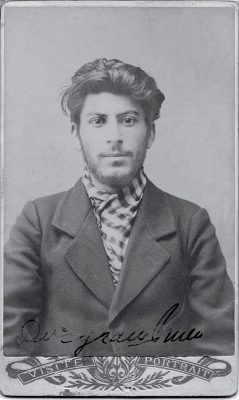Joseph Stalin was born Ioseb Besarionis dze Jughashvili on the 18th of December, 1878, in the town of Gori, Georgia, which was part of the Russian Empire. He was given the nickname “Soso” and grew up in a community composed of Russian, Armenian, Jewish, and Georgian people. His father was Besarion Jughashvili, and his mother was Ekaterine Geladze. Ioseb was the only child of Besarion and Ekaterine to live past infancy.
Besarion was a cobbler who worked in a shoemaking shop managed by another man. At first, the business generated income, but it eventually faded away, leaving Berasion’s family in poverty. He became a heavy drinker and regularly hit his wife and Ioseb. In 1883, Ioseb and his mother left Besarion and moved about from one rented room to another. After three years of drifting, they settled into the home of a local priest named Father Christopher Charkviani. There, Ekaterina worked as a clothes washer and house cleaner. In 1888, Ioseb entered the Orthodox Gori Church School, where he got involved in several fights with other boys. Nonetheless, Ioseb did well in his studies and showed painting, poetry, and choir singing abilities. When he was 12 years old, Ioseb’s left arm was hit by a carriage, and the accident left him with a permanent injury.
At 16, Ioseb trained as a priest at the Orthodox Spiritual Seminary in Tiflis, where he attained high marks. However, he became disinterested in the following years and neglected his studies. He took on a rebellious attitude and announced that he was an atheist. He started to read books that were prohibited in school. He immersed himself in the novel “What Is To Be Done?” by Nikolay Chernyshevsky. Ioseb also read the social philosopher Karl Marx’s Das Kapital and committed himself to Marx’s theories. His night-time activities included undercover meetings with fellow socialists. Ioseb left the Orthodox Spiritual Seminary in 1899.
In 1899, Ioseb worked as a weatherman at the Tiflis Observatory. During his time there, he drew a group of followers by lecturing about socialist theory. He also successfully enticed his followers to stage a labor strike. His activities eventually attracted the attention of the Okhrana, the Russian Empire’s secret police. The Okhrana tried to arrest Ioseb in 1901, but the young revolutionary evaded them and vanished out of sight, helped by friends and supporters. By the end of 1901, he was voted into the Marxist party named Tiflis Committee of the Russian Social Democratic Labor Party. Around the same time, Ioseb worked at the Rothschild refinery storehouse, where he successfully incited his co-workers to stage a public demonstration. One demonstration led to troops firing at and killing 13 demonstrators. On the day of the funeral itself, Ioseb organized another major demonstration. He was eventually caught and imprisoned in Batumin Prison and was later transferred to Kutaisi Prison. In 1903, he was sent to eastern Siberia to serve a sentence of three years of exile. Around this time, Ioseb took on the name Stalin, which in Russian means “man of steel.”
In November 1903, Stalin was sent to Novaya Uda, a small town in Siberia, where he lived in a peasant’s cottage. He attempted to escape but only managed to reach Balagansk before turning back because of frostbite. He tried to escape again in January 1904, and this time, he made it all the way to Tiflis. He busied himself by co-managing a Georgian Marxist newspaper, Proletariatis Brdzola, or the Proletarian Struggle. All this time, the Russian Empire’s secret police had him on its list, so he had to conduct his work underground while raising funds through extortion and kidnappings. In 1907, Stalin became involved in an armed robbery of a bank in Tiflis. The robbery resulted in the deaths of 40 people and several others injured, and a total stolen amount of 241,000 rubles. Today, the amount is equivalent to 3.3 million U.S. dollars.
The Russian Revolution began in February 1917. The following month, the Tsar left the throne and was held under house arrest. At first, the revolutionaries favored a temporary government, thinking that a peaceful hand-over of power was workable. This all changed in April, when the leader of the Bolsheviks, Vladimir Lenin, criticized the temporary government. Lenin incited the masses to revolt and claim for themselves the factories of the industrialists, along with their land. The revolution accomplished its goal by October, and the Bolsheviks wielded power.
The new government went off on a tumultuous start as powerful personalities struggled for power and domination. The revolutionaries were only a small group, and their nation was a vast one. However, in 1922, Stalin was designated as the general secretary of the Communist Party. During that time, it was not a powerful position, but it was enough to enable Stalin to oversee member appointments in the party and keep surveillance on his colleagues. This allowed him to establish a stronghold in the party and start to consolidate power. He made appointments that favored his interests, and soon, all men who comprised the central command were all appointees of Stalin, with their position and power indebted to him. Eventually, it became clear to all what Stalin had accomplished for himself. By then, the revolutionary from Georgia was too powerful for anybody in the Communist Party, even for Lenin.
